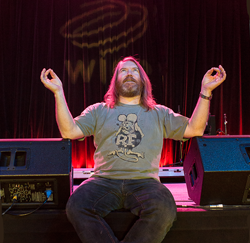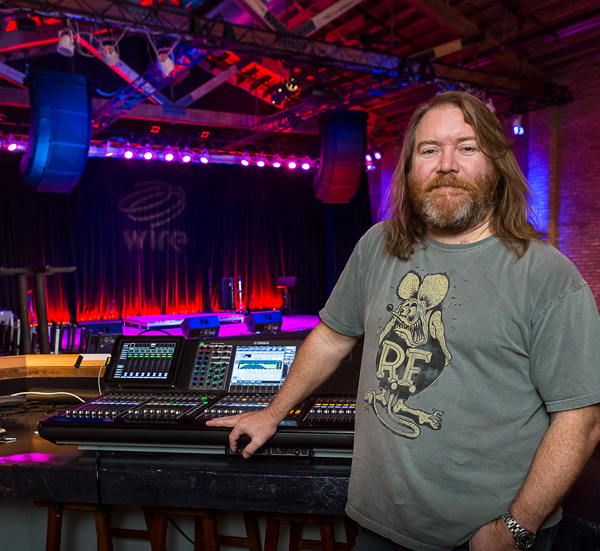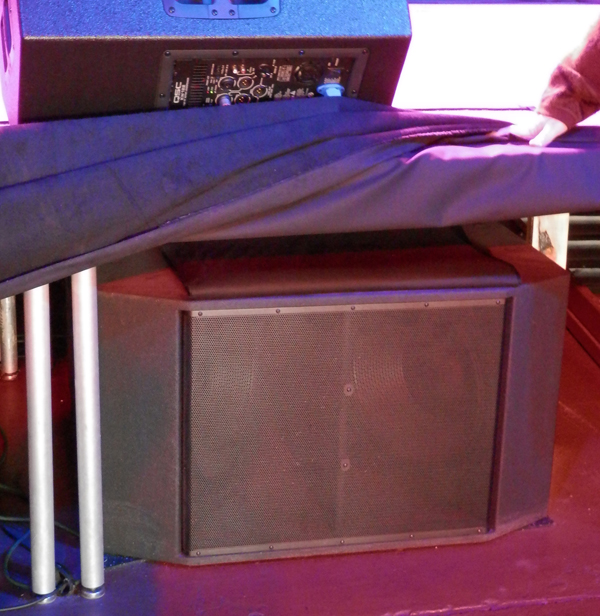
Main Configuration
What resulted are flown left and right main full-range arrays flanking the Wire stage, each comprised (bottom to top) of one RM12020 module, two RM9020 modules, and a RM7010 module.
The model numbers reveal the coverage patterns of the modules, with horizontal coverage wider at the bottom (120 by 20 degrees) and then tapering to more narrow (90 by 20 and then 70 by 20 degrees) as you move up the array. The result, according to Bolger, is uniform coverage of the room both front to back and side to side.
“Dispersion is very even, and there’s distinct clarity in fully revealing the subtle detail of the music,” he states. “You can walk anywhere in the room and the hi-hat doesn’t go away, the vocals don’t go away, the real character of the music doesn’t go away.”
The open nature of the space and a truss grid above the stage translated to easy selection of optimum locations to fly the arrays. Meanwhile, there wasn’t enough height to fly the subwoofers with the arrays, so to keep the floor clear of obstructions, the system’s two RMS218 (dual-18-inch) subs are positioned together beneath the center/front of the stage, and they’re in a cardioid configuration topped by a judicious use of digital processing to help keep their output under control.
All main system loudspeakers and the subs are driven by four Bose Professional PowerMatch PM8500N networked amplifiers and managed by a ControlSpace ESP-00 digital processor using four ESP I/O cards. These components are located backstage.
Mix & I/O
The other primary component in the system is a Yamaha Commercial Audio CL5 digital console that’s capable of handling both house and monitors. Fronting the custom sound booth constructed in one of the rear corners of the room, it provides plenty of capabilities for guest engineers.
The console is linked via (Audinate) Dante networking to two Rio stage boxes, one to each side of the stage, that accommodate up to 64 inputs, with another eight inputs available on the console.
“The CL5 is a great choice for this application,” O’Connell notes. “The technology is proven, engineers like to mix on it, there’s plenty of capability, plus we’ll be able to link it via Dante to the recording studio system when it’s ready.”
“This is an excellent console both sonically and operation-wise, with plenty of onboard facilities in terms of effects,” Bolger adds. “Plus it’s great for teaching our students. We like to get them behind the board and show them the cause and effect of what they’re doing on stage as it relates to what’s happening with sound in the house.”

Currently a Dante run from the console feeds a multitrack recorder for capturing live performances, and Cat-5 is also in place to facilitate a Dante link to the main system rack in the near future. (That feed is analog for the time being.)
There really weren’t many options with respect to the booth location – placing it centrally would have impeded crowd traffic flow while also occupying too much prime listening real estate. However, this difficulty is largely alleviated with the use of the console’s StageMix app with an iPad that’s kept at front of house, allowing engineers to dial in the mix from anywhere in the room.
At The Stage
This applies to monitors as well, with the CL5 accommodating up to 16 mixes on stage. Several QSC KW122 (12-inch) active 2-way loudspeakers are available for artists, placed horizontally on their cabinet’s monitor position, with a 15-inch KW152 provided for drum fill. They’re also outfitted with EQ modes for switching between optimized settings with the press of a button on the back panel.
“I really like these boxes as monitors. Both the 12s and 15s get it done,” Bolger says. “I also like that you can adjust them if you want. It’s incredible what compact loudspeakers can do these days.”
“Actually, my band played at Wire a few months ago, and as a musician, I found the stage monitoring situation to be great,” O’Connell adds.
The microphone package offers a variety of models from Shure (SM57 and SM58, several BETA mics, and three KSM137 condensers). Direct needs are met with Radial Engineering ProDi boxes as well as a ProD8 providing eight channels in a single rack-mount box.
All of the equipment hadn’t arrived as the venue’s grand opening date approached, so TC Furlong supplied loaner gear from its extensive rental stock to handle the situation until everything was delivered and installed. The company also provided training on the console and a technician for opening night.
Desired Result
Wire is convenient to expressways and public transportation, seeing notable success in attracting patrons from all over the Chicagoland area for live music several nights a week. It’s already garnered a reputation among musicians as a place to play and be heard, and among patrons who appreciate the care that’s gone into creating the venue.
“It sounds more like a concert hall than a club,” says O’Connell. “This system sounds fantastic, to us and to the club’s owners and to everyone who’s been there.”
“We set out to create a place where we’d want to play as artists, and that’s led to a great result and what we see as a valuable addition to the area music scene,” Bolger concludes. “We’ve worked carefully in how we’ve allocated our resources, and those choices have paid off for everyone involved.”
Keith Clark is editor in chief of ProSoundWeb and Live Sound International.


